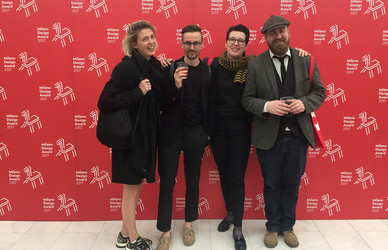Wonders of Curiosity
On 6 August 2012 at 7:31AM Danish time, Curiosity landed on Mars, nine months after launch. A lonely mission even for a robot with no humans to share and report what Mars is really like.
One of NASA’s most important jobs is to make science and difficult data comprehensible to ordinary people. In this case, NASA uses Twitter to communicate what the Mars robot Curiosity discovers.
This and the cross-field between personal communication and two different data sets inspired students Josefin Olivia Hultsbo, Camilla Wedege Kristensen and Esben Møller Rahbek to present the Mars robot Curiosity with a personality. The students used one data set from the Mars robot Curiosity and one from Harvard that shows how you are able to read mood swings from an entire day based on Twitter tweets. Based on that information they set up the Instagram profile @wondersofcuriosity.
- By combining these two sets of data – a picture taken by the Mars robot and Haiku poems that represent the state of mind – you are able to portray an image of Curiosity’s mood that reflects mood swings you would see on Earth. In order to make young people relate to that we have given Curiosity a personal profile on a social media that mixes the personal and the general scientific communication, says Teacher and Head of International Innovation Barnabas Wetton.
Come on – we are still here
In just three weeks @wondersofcuriosity has gained over 1000 followers and people all over the world are sending encouraging comments when the robot is feeling a bit down:
DAYS ON MARS: 1146
Feeling alone
I stand here alone
Wishing I had a real home
Everyone has gone
One user replies:
- Hey come on! We are still here. Following you and your great leaps for the whole human race. Keep a little bit more of the sun on your solar panels and just move on.
- It’s amazing the amount of attention that Curiosity’s profile has gained and it shows that one of the most important aspects of being a designer is your ability to handle, simplify and communicate data, Barnabas Wetton explains.
Taste Mars
Another project with NASA that has also received a lot of attention is inspired by the recent news that there is water on Mars and is made by students Malte Younen Eskestad, Christina Tran, Cecilie Vår Norsahl and Runi Hedinsson Ellingsgaard. They have asked the question, what would water on Mars taste like?
And around 3000 people got to experience that at the Copenhagen Cultural event in October when they tasted ice made from a recipe of salt, water and soil. A ‘treat’ that looked very similar to the red-brown planet.
- Some were upset by the intensity of the flavor. Others were amazed because it created a space from which to understand another planet as well as their own standpoint and the way that we sense our surroundings, Barnabas Wetton explains.
- We all know how wood and metal taste because our body remembers that from past childhood experiences. The ice from Mars triggers these bodily experiences – it’s almost like being there yourself. Like getting sand in your mouth reminds you of going to the beach on a hot summer day. The ice project enables people to experience the knowledge that NASA produces on a bodily and an emotional level, Barnabas Wetton explains.
Projects that resonate
NASA is thrilled about the innovative solutions and have already made plans to present the projects inhouse.
- The students have managed to lift the project beyond anyone’s expectations and have given us new and innovative ways to understand and use data visualisations, Barnabas Wetton ends.




